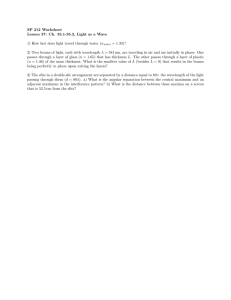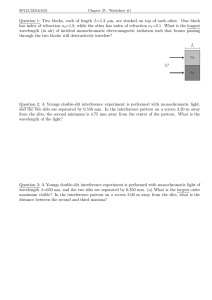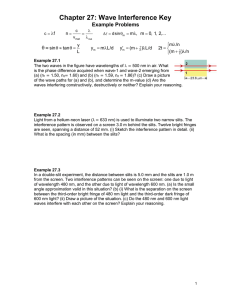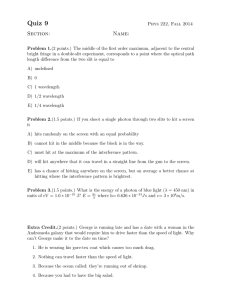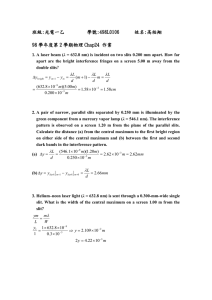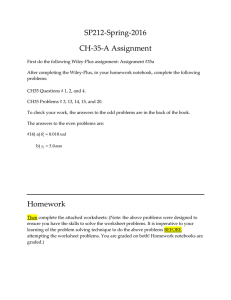Interference of Light Waves: Double Slit & Fringes
advertisement
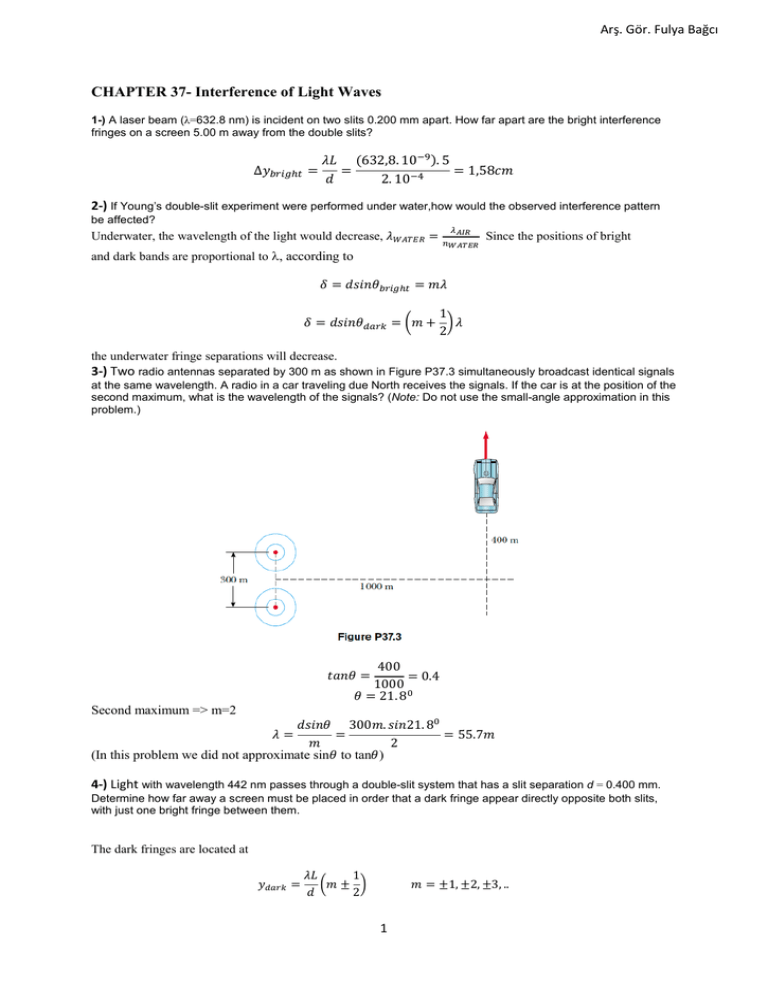
Arş. Gör. Fulya Bağcı CHAPTER 37- Interference of Light Waves 1-) A laser beam (λ=632.8 nm) is incident on two slits 0.200 mm apart. How far apart are the bright interference fringes on a screen 5.00 m away from the double slits? ∆𝑦𝑏𝑟𝑖𝑔ℎ𝑡 = 𝜆𝐿 (632,8. 10−9 ). 5 = = 1,58𝑐𝑚 𝑑 2. 10−4 2-) If Young’s double-slit experiment were performed under water,how would the observed interference pattern be affected? Underwater, the wavelength of the light would decrease, 𝜆𝑊𝐴𝑇𝐸𝑅 = and dark bands are proportional to λ, according to 𝜆𝐴𝐼𝑅 𝑛𝑊𝐴𝑇𝐸𝑅 Since the positions of bright 𝛿 = 𝑑𝑠𝑖𝑛𝜃𝑏𝑟𝑖𝑔ℎ𝑡 = 𝑚𝜆 1 𝛿 = 𝑑𝑠𝑖𝑛𝜃𝑑𝑎𝑟𝑘 = �𝑚 + � 𝜆 2 the underwater fringe separations will decrease. 3-) Two radio antennas separated by 300 m as shown in Figure P37.3 simultaneously broadcast identical signals at the same wavelength. A radio in a car traveling due North receives the signals. If the car is at the position of the second maximum, what is the wavelength of the signals? (Note: Do not use the small-angle approximation in this problem.) 400 = 0.4 1000 0 𝜃 = 21. 8 𝑡𝑎𝑛𝜃 = Second maximum => m=2 𝑑𝑠𝑖𝑛𝜃 300𝑚. 𝑠𝑖𝑛21. 80 = = 55.7𝑚 2 𝑚 (In this problem we did not approximate sin𝜃 to tan𝜃) 𝜆= 4-) Light with wavelength 442 nm passes through a double-slit system that has a slit separation d = 0.400 mm. Determine how far away a screen must be placed in order that a dark fringe appear directly opposite both slits, with just one bright fringe between them. The dark fringes are located at 𝑦𝑑𝑎𝑟𝑘 = 𝜆𝐿 1 �𝑚 ± � 𝑑 2 𝑚 = ±1, ±2, ±3, .. 1 Taking m = 0 and y = 0.200 mm in the above equation, 𝐿≈ 2𝑑𝑦 2(0,4. 10−3). (0,2. 10−3 ) = = 0.362 𝑚 = 36.2 𝑐𝑚 442. 10−9 𝜆 Geometric optics incorrectly predicts bright regions opposite the slits and darkness in between. But, as this example shows, interference can produce just the opposite. 5-) Two slits are separated by 0.320 mm. A beam of 500-nm light strikes the slits, producing an interference pattern. Determine the number of maxima observed in the angular range -30.0° < θ< 30.0°. At 30.0° , d sin θ = mλ e3.20 ⋅ 10 mjsin30.0°= me500 ⋅ 10 mj -4 -9 so m=320. There are 320 maxima to the right, 320 to the left, and one for m = 0 straight ahead. There are 641 maxima. 6-) In a double-slit arrangement of Figure 37.5, d =0.150 mm, L= 140 cm, λ=643 nm, and y= 1.80 cm. (a) What is the path difference " for the rays from the two slits arriving at P ? (b) Express this path difference in terms of λ. (c) Does P correspond to a maximum, a minimum, or an intermediate condition? Figure 37.5 (a) Geometric construction for describing Young’s double-slit experiment (not to scale). (b) When we assume that r1 is parallel to r2, the path difference between the two rays is r2 - r1= d sinθ. For this approximation to be valid, it is essential that L>>d. (a) The path difference δ=yd/L δ = d sinθ and when L >> y =(1,8.10-2.1,5.10-4)/1,4=1,93µm (b) δ/λ=(1,93.10-6/6,43.10-7)=3 δ=3λ (c) Point P will be a maximum since the path difference is an integer multiple of the wavelength. 2 7-) The intensity on the screen at a certain point in a doubleslit interference pattern is 64.0% of the maximum value. (a) What minimum phase difference (in radians) between sources produces this result? (b) Express this phase difference as a path difference for 486.1-nm light. (a) 𝐼 𝐼𝑚𝑎𝑥 𝜙 2 = 𝑐𝑜𝑠 2 � � Therefore, φ=1.29 rad. (b) 𝛿 = 𝜆𝜙 2𝜋 = 486𝑛𝑚.1,29𝑟𝑎𝑑 2𝜋 = 99,8𝑛𝑚 8-) Monochromatic coherent light of amplitude E0 and angular frequency ω passes through three parallel slits each separated by a distance d from its neighbor. Show that the time-averaged intensity as a function of the angle θ is The resultant amplitude is 2𝜋𝑑𝑠𝑖𝑛𝜃 2 𝐼(𝜃) = �1 + 2𝑐𝑜𝑠 � �� 𝐼𝑚𝑎𝑥 𝜆 2𝜋 Er = E0 sinωt + E0 sinbωt +Φ g+ E0 bω t + 2 Φ g, where 𝜙 = 𝑑𝑠𝑖𝑛𝜃 𝜆 Er = E0 (sinωt+sinωt.cosΦ+cosωt.sinΦ+sinωt.cos2Φ+cosωt.sin2Φ) Using the trigonometric relations of cos2Φ=2.cos Φ-1, sin2Φ=2sinωt.cosΦ, 2 Er = E0.sinωt.(1+ cosΦ+2.cos2Φ-1)+ E0.cosωt.(sinΦ+2sinΦcosΦ) Er = E0 (1+2cosΦ)(sinωt.cosΦ+cosωt.sinΦ)= E0 (1+2cosΦ)sin(ωt+Φ) Then the intensity is 1 𝐼~𝐸𝑟2 = 𝐸02 (1 + 2𝑐𝑜𝑠𝛷)2 � � 2 Where the time average of 𝑠𝑖𝑛2 (ωt + Φ) = 1/2 1 � so 2 From one slit alone, we would get intensity 𝐼𝑚𝑎𝑥~𝐸02 � 2𝜋𝑑𝑠𝑖𝑛𝜃 2 𝐼(𝜃) = �1 + 2𝑐𝑜𝑠 � �� 𝐼𝑚𝑎𝑥 𝜆 3
